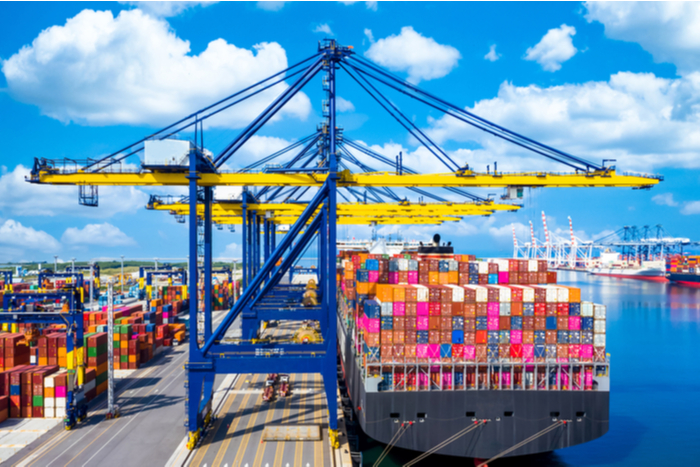
Retailers could encounter capacity constraints if carriers blank more sailings in the third quarter. Photo credit: Shutterstock.com.
The outlook for US imports this summer and fall is brightening a bit, but peak season container volumes will be down from last year by close to double-digits as the economy contends with high unemployment and cautious consumer spending due to the COVID-19 pandemic, retailers say.
If imports from Asia improve from a disastrous spring, as forecast in Monday’s Global Port Tracker published by the National Retail Federation (NRF) and Hackett Associates, retailers could face space constraints in the eastbound trans-Pacific this summer. Carriers last week announced 42 blank sailings to North America from June 1 through Aug. 9, according to Sea-Intelligence Maritime Consulting.
“The impact of COVID-19 at major US retail container ports appears to be easing slightly, with projected imports remaining below last year’s levels but not as much as previously forecast,” Global Port Tracker stated.
“The numbers we’re seeing are still below last year, but are better than what we expected a month ago,” said Jonathan Gold, NRF’s vice president for supply chain and customs policy. The year-over-year monthly projections in the May Global Port Tracker have been revised up a percentage point or two, but are still mostly negative by double digits compared with last year because consumers do not appear to be back to normal spending trends.
“Getting 40 million people back to work will take time, especially with many fearful of catching the virus and staying home. That makes a rapid return to an economic boom unlikely,” said Ben Hackett, founder of Hackett Associates.
US containerized imports in June are forecast to be down 12.9 percent year over year. July imports will decline 17.4 percent, August down 12.9 percent, September down 11.3 percent, and October down 7.9 percent, according to Monday’s Global Port Tracker. US containerized imports from Asia in January through April were down 5.4 percent from the same months last year, according to PIERS, a sister product of JOC.com within IHS Markit.
On the other hand, October will represent the first month since April that year-over-year imports would decline by less than double digits, Global Port Tracker stated.
‘Uncertainty abounds’
The forecast for a slight improvement follows reports of overbooked vessels, cargo rolling, and increasing spot rates in the eastbound trans-Pacific the past two weeks. Friday’s spot rate of $2,132 per FEU from Shanghai to the West Coast was 48.2 percent higher than the same week last year. The East Coast rate of $2,738 per FEU was 9.4 percent higher year over year, according to the Shanghai Containerized Freight Index, which is published under the JOC Shipping & Logistics Pricing Hub.
However, non-vessel operating common carriers (NVOs) generally said the late-May spike in US imports was due to factors such as inventory replenishment and shipments of seasonal summer and back-to-school merchandise, rather than a steady increase in imports that will be sustained through the peak season.
“This is not a matter of demand being back to normal. It’s just replenishment,” Christian Sur, executive vice president of sales and marketing at Unique Logistics International, told JOC.com last week.
Retailers are still preparing for a holiday shopping season beginning with Black Friday on the day after Thanksgiving. But not an extended season, Sur said. “It will be one to two weeks, maybe, but not two months,” he said.
Jack Chang, managing director of JUSDA, also an NVO, said the US trade with Asia has settled into a pattern where personal protective equipment (PPE) and other medical supplies that had been moving via air freight at the height of the COVID-19 outbreak this spring are now moving on scheduled liner services. The same applies to some electronics goods and components that had been front-loaded, he said.
The recent spike in import volumes is encouraging for carriers, who rely upon strong peak-season volumes in order to increase their freight rates through surcharges. Carriers have already received some criticism from NVOs for canceling sailings in late May, which resulted in a number of shipments being rolled and spot rates surging higher.
Carrier executives said their decisions on capacity deployment have been hampered by the inability of retailers and other customers to forecast their demand several months in advance, as they are normally able to do. A liner executive last week told JOC.com carriers have no insight into retail purchase orders with Asian factories. “We rely on our customer forecasts,” he said.
Retailers are not yet ready to forecast a strong trans-Pacific peak season, which normally runs from August through October, but neither are they pessimistic about prospects for some level of recovery.
“Is it possible the worst of the coronavirus pandemic is behind us? Maybe, but we are not out of the woods yet, and uncertainty abounds,” Jack Kleinhenz, chief economist at the NRF, said last week in a release. He added that history does not give retailers much help in predicting what consumer spending will be like during the holiday shopping season during a pandemic.
Record drops in employment, gross domestic product, retail sales, and other indicators have resulted in “such unparalleled numbers that it is not comparable to anything in economic history and has yet to catch up with the reality of what we are experiencing,” Kleinhenz said.
Nevertheless, carriers have already announced more than 40 blank sailings to take place over the next two months because they believe US imports in the summer months will trail off until imports of holiday merchandise pick up in August. Additional Q3 blank sailings could be coming as one of the three major vessel-sharing alliances has yet to announce significant cancellations, Alan Murphy, CEO of Sea-Intelligence, said in this week’s Sunday Spotlight.
“The blanking of sailings for 2020-Q3 is gathering pace quickly, but thus far mainly from only 2M and THE Alliance, with Ocean Alliance holding back for now,” Murphy said.
Contact Bill Mongelluzzo at [email protected] and follow him on Twitter: @billmongelluzzo.

